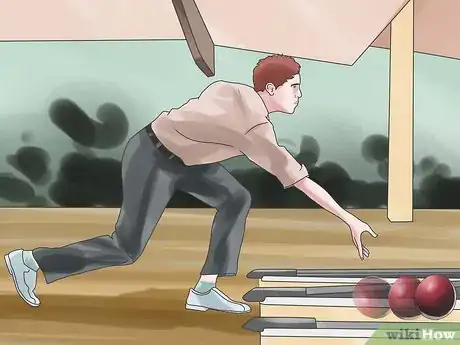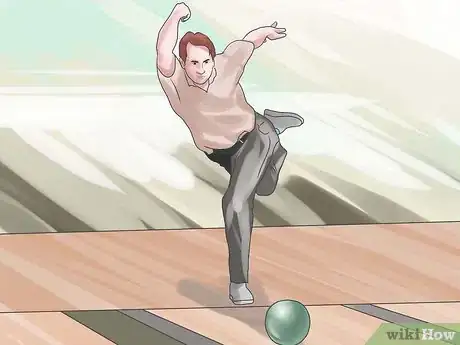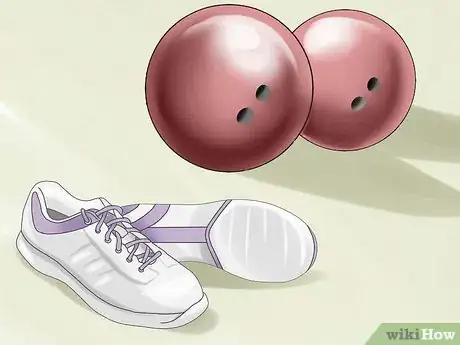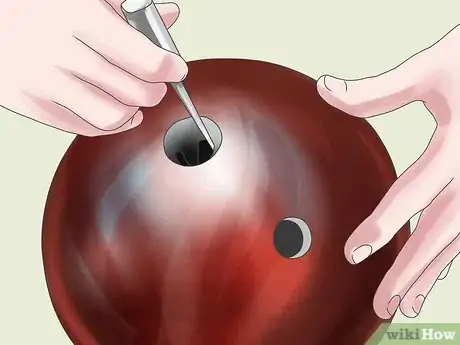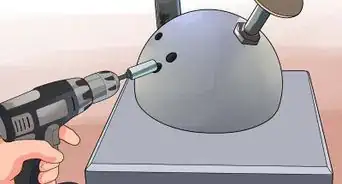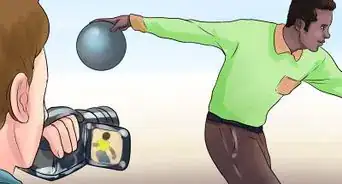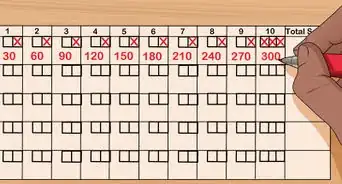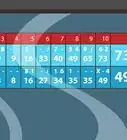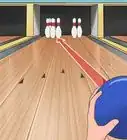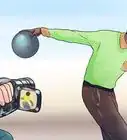wikiHow is a “wiki,” similar to Wikipedia, which means that many of our articles are co-written by multiple authors. To create this article, 55 people, some anonymous, worked to edit and improve it over time.
wikiHow marks an article as reader-approved once it receives enough positive feedback. In this case, 90% of readers who voted found the article helpful, earning it our reader-approved status.
This article has been viewed 1,424,877 times.
Learn more...
Are you a beginner looking to take that next step and improve your bowling game? If you want to hook a bowling ball, then all you need is to master the proper grip and technique and to follow through. Oh, and you need some time and patience too! Soon enough, your friends will be bowled over by your amazing skills.
Steps
Mastering the Technique
-
1Visualize the line you'll take across the lane. Depending on the lanes you bowl on, this can vary greatly, but let's focus on a typical house condition: most of the oil is on the inside, leaving roughly 8-10 boards of relatively dry lane to be used. These boards can be both friend and enemy to you. Depending on the amount of oil and the way your ball reacts to different lane conditions, you will want to line up your feet slightly to the left-hand side of the lane. Once you get more familiar with your hook, you can adjust your set-up as necessary.
- Starting with your right foot on the middle dot on the approach is a good way to test how much the lanes are hooking. It is important to keep your feet closely together to maintain alignment.
-
2Stand with your heels several inches from the foul line. Take the amount of steps in your approach away from the lane to determine your starting position. If you have a 4-step approach take 4 steps, etc. You then want to aim to throw your ball at one of the arrows on the lane. The easiest way to aim is to use the arrow markings or the dots that are just before the arrows on the lane.
- For this tutorial, you should start off aiming somewhere around the second arrow on the right, allowing the ball to roll over this arrow, move out to only a few boards from the gutter, and then hook from the dry spot of the lane (about 38 to 40 feet down on a house shot) all the way back to the 1-3 pocket.
- For a left-hander, this would be the 2nd arrow on the left, and the ball would hook to the 1-2 pocket.
Advertisement - For this tutorial, you should start off aiming somewhere around the second arrow on the right, allowing the ball to roll over this arrow, move out to only a few boards from the gutter, and then hook from the dry spot of the lane (about 38 to 40 feet down on a house shot) all the way back to the 1-3 pocket.
-
3Make the swing. A 4-step approach is recommended, though you can use as little as 1 step and as many as 8 (though most steps over 4 are basically just timing steps where your ball doesn't move). For a 4-step approach:
- Push off the ball on your first step, stepping with your right foot first for right-handed players
- Have the ball be parallel to your ankle at the 2nd step, and start to bend at your knees
- Be at the top of your backswing by your third step
- Bring the ball back through and release by the end of your slide.
- With 5 steps, it's basically the same thing, only you'll start with your left foot instead, and the ball won't move for that first step.
-
4Keep your arm completely straight the entire way through your swing. Having your arm tucked too far behind you or held too far away from your body will cause a bad angle when you release the ball. It's easiest to keep your arm straight if you adjust your push away.
- There are many different styles, like bending at the waist (a la Walter Ray Williams Jr. or Wes Malott) or opening your shoulders (a la Tommy Jones or Chris Barnes) when you bring your arm up for the backswing, but sticking to the basics is a good idea when first learning how to do this.
- Remember, you want the ball to hook when it gets to the dry area at the back of the lane, but until it gets there, the ball should be traveling a relatively straight path, varying only a few boards at most. Again, everyone has a different style, and you can adjust this as you feel comfortable.
-
5Time your release. As you begin to drop the ball out of the backswing, make sure that your palm is directly underneath the ball, facing upwards. Now, as the ball starts to approach your ankle, you want to rotate the ball so that when you release your hand, it is on the side of the ball and slightly under it, just as if you were holding a football to throw an underhand spiral. Then follow through as though you were going to be shaking hands with the pins.[1]
- A good way to practice this technique is to actually throw an underhand spiral with a football; similar physics are involved. You can also practice with a tennis ball. If you get it right, it'll go straight and then bounce drastically to the side.
-
6Follow through. Just as important as the release itself is following through with your arm after you let go of the ball. After release it is important to follow through outward onto the lane, not upward. Your fingers will create the upward lift without you having to lift upward on the ball.[2]
- An easy way to remember this is the old ESPN advert: "Roll the ball, then answer the phone." Though, hopefully you have better form than the guy in that commercial. And remember, fluidity here is essential: don't do the hand-shake, pause slightly, and then do the follow through -- it must all be one smooth motion. A good follow through is crucial to maintaining consistent ball speed and accuracy.
-
7Make the necessary adjustments. Once you are comfortable with your release and can execute it properly on a consistent basis, you can learn to adjust your footwork in tandem with your release. On a house pattern, you want to move the direction you are missing.
- For a right-hander, if your ball hits high (to the left of the headpin), then try moving your feet a couple of boards to the left and keeping your target on the lane the same as before.
- If you hit the pocket light (to the right of the 3 pin), try moving your feet a couple of boards to the right and keep your target the same. It is important to move your target on the lane when you move your feet. Otherwise you may end up playing very weird angles.
- Once you become more advanced and start playing on more challenging sport lane conditions, the left and right moves become more complicated and sometimes speed and hand adjustments are required.
Customizing Your Bowling Ball
-
1Get the right equipment. No matter what you do, if the bowling ball can't catch any friction on the lanes, it's not going to hook. Generally, you need a ball made of Reactive Resin or better (e.g. particle-load or newer epoxy resin cover stocks) for anything but the driest of lanes. These are very easy to find and can be bought at relatively little expense, though resin is more expensive than urethane cover stock and will be an investment in your game.[3] Check out your alley -- how oily are the lanes?
- Though most bowling centers do offer "house balls," they are generally plastic (polyester) and won't hook very much, though they are good for most spares since they will travel very straight.
- Having your own plastic ball for spares (spare ball), and a resin ball for strikes and some spares (spare ball) is a good idea for any level of bowler as house balls don't usually fit your hand perfectly and won't carry pins very well.
-
2Use the proper grip. When you're getting your ball custom-fitted to your hand, you want to know how you hold the ball, your point of axis, and how your grip lies. Grip the ball with the two middle fingers (the middle and ring fingers) of your dominant hand (i.e. the hand you write with), and place your thumb the whole way into the thumb hole.[4] There are 2 main types of grips:
- Conventional: the middle and ring fingers are inserted up to the second knuckle (this is seen in most house balls)
- Fingertip grip: the same fingers are inserted only up to the first knuckle (fingertip grips will give you more revs than a conventional grip and are easier to hook)
- A new thing out these days in the bowling community are Vacu-Grips. These grips will expand and contract to your finger width; this helps if you are going to bowl a lot. You will find that most of the pros use a fingertip grip as it allows you to get your thumb out of the ball first allowing you to "lift" with your fingers creating revs on the ball.
-
3Have your ball(s) drilled correctly. This is a personal thing depending on how and where you bowl, so you will need to talk to your local pro-shop operator for advice on this one. The drilling for the ball is very important, if not crucial, so make sure the drilling is appropriate for the conditions you bowl on and your own physical limitations. Obviously, it is critical that your own ball is fitted to your hand, but if you purchase a ball, the pro shop operator will do this as part of the cost of the drilling.
- Talk to your pro-shop guy about your wants -- he may be able to recommend things you don't realize you need. Maybe a fingertip grip? A lower or higher RP differential (lower differential hooks on pearl or matte coverstock, higher on resin)? Or even a different ball or different weight completely!
Community Q&A
-
QuestionAre there any special tricks for hooking a bowling ball?
 Daren NgoCommunity AnswerHere's the secret. When you lift the ball with three fingers, rotate your hand and wrist (Righties: counter-clockwise; Lefties: clockwise). The first digit that should go out of the ball when you release it is the thumb. When you release, if you were successful, it will curve, go on the edge of the gutter, and knock down around 6-10 pins varying on the angle of the shot.
Daren NgoCommunity AnswerHere's the secret. When you lift the ball with three fingers, rotate your hand and wrist (Righties: counter-clockwise; Lefties: clockwise). The first digit that should go out of the ball when you release it is the thumb. When you release, if you were successful, it will curve, go on the edge of the gutter, and knock down around 6-10 pins varying on the angle of the shot. -
QuestionI have been hooking my ball and now it no longer hooks. What could be the problem?
 Community AnswerYour ball may be soaked with oil. I would recommend having your ball rejuvenated (i.e baked and refinished).
Community AnswerYour ball may be soaked with oil. I would recommend having your ball rejuvenated (i.e baked and refinished). -
QuestionHow much should I cock my wrist?
 Daren NgoCommunity AnswerNot too much (around a punching position). This creates too much curl to it making the ball curl into the gutter. Here's a tip: Cock your wrist into a sort of handshake position. This will create curl that makes the ball go on the edge of the gutter and knock down pins around the front center pin.
Daren NgoCommunity AnswerNot too much (around a punching position). This creates too much curl to it making the ball curl into the gutter. Here's a tip: Cock your wrist into a sort of handshake position. This will create curl that makes the ball go on the edge of the gutter and knock down pins around the front center pin.
Warnings
- Be very careful when first trying this. If you can, use a lighter weight ball than you're used to at first, just to get the feel for the release. It is also a good idea to have a more experienced bowler or coach watch you while you do it.⧼thumbs_response⧽
- Lane conditions can dictate how much hook potential you have. If you are not making it to the pocket or crossing over onto the Brooklyn side, it may be the lane conditions, therefore don't try to crank the heck out of the ball at first, learn to adjust. It is after all the most important thing in bowling!⧼thumbs_response⧽
- This release is prone to injury if done incorrectly, so again be very careful and try not to over-throw it. As in golf, less is more. It's more about swing mechanics than raw power here. If you "crank" too much it can result in serious wrist, elbow, or shoulder injury.[5]⧼thumbs_response⧽
Things You'll Need
- A resin bowling ball with a moderate hook rating that is good for the entry level bowler. Once you have learned to hook it, a more aggressive ball may be appropriate.
- A towel, preferably a micro-fiber towel to wipe off oil between shots. Resin bowling balls absorb oil on every shot. Wiping them often and using oil removing cleaner between series will help maintain their longevity. Otherwise they will lose some of their hook and consistency after a few hundred games.
- If you are having trouble keeping your wrist straight you may also need a wrist brace to prevent injury and keep your wrist straight. Wrist braces help create more consistency as they limit your wrist's range of motion. Consult your pro shop to see what size and style will be best for you.
- Bowling shoes. Having your own shoes is important to the consistency of your slide as well as balance and timing.
- A bowling video can help you a lot. Currently, someone has uploaded Walter Ray Williams Jr.'s 3 part video lessons to YouTube under: Walter Ray Williams Jr. video.
- A coach. It is important, especially for beginners, to have a coach. Practicing without one can sometimes lead to the development of bad habits. A few lessons are a good idea for someone just learning to bowl. Coaches are like a human manual that can help you forget your bad habits and maintain good ones.
References
- ↑ https://www.dummies.com/sports/bowling-for-dummies-cheat-sheet/
- ↑ https://www.dummies.com/sports/bowling-for-dummies-cheat-sheet/
- ↑ https://www.myactivesg.com/Sports/Bowling/Training-Method/Bowling-for-Beginners/How-to-make-a-bowling-ball-curl
- ↑ https://www.myactivesg.com/Sports/Bowling/Training-Method/Bowling-for-Beginners/How-to-make-a-bowling-ball-curl
- ↑ https://www.myactivesg.com/Sports/Bowling/Training-Method/Bowling-for-Beginners/How-to-make-a-bowling-ball-curl
About This Article
To hook a bowling ball, start by taking a few steps toward the foul line and bringing the ball back into a backswing. Then, as you come out of the backswing, keep your palm directly underneath the ball so that it's facing upward. As the ball starts to approach your ankle, rotate your hand so your palm is now on the side of the ball but still slightly under it. Finally, release the ball and follow through with your hand as if you're going to be shaking hands with someone. To learn the best way to approach the foul line when you're trying to hook a bowling ball, keep reading!




